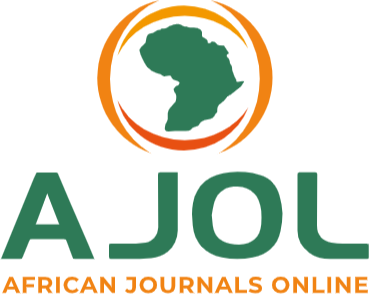Radiation Doses in Fishing Water and Coast Soil in Lagos State South West Nigeria
Keywords:
Gold, minerialization, maturity, AbujaAbstract
Kayode Idowu Ogungbemi*, Williams Igoniye ; Ibitoye Ayo Zaccheaus; Margret Abosede. Adedokun, Olusola Olurotimi Oyebola
This study investigated the radionuclide concentrations in soils and waters of the Coastline and some selected aquatic commonly consumed in this area. Radioactivity levels were evaluated in their natural occurrences in the samples of water, soil and selected aquatic life from three different locations in the Mainland part of Lagos State (Makoko, University of Lagos waterfront and Bariga). Canberra High Purity Germanium Gamma spectrometer was used for the detection of radionuclides and determines the activity. The activity concentrations of Pb-214, Pb-212, Cs-134, and K-40 in the Soil samples of Makoko were found to be 7.89±0.51, 10.20±1.21, 0.69±0.10 and 67.37±2.52 Bq/kg, respectively. From the University of Lagos waterfront, the concentrations of the Soil samples were found to be 8.22±0.51 Bq/kg for Pb-214, 10.54±1.19 Bq/kg for Pb-212, 0.57±0.15 for Cs-134. For the selected Aquatic life (Tilapia Fish, Cat Fish and Crab) from these three locations of interest. The concentrations of K-40 ; Pb-
214;Pb-212 Cd-113; Ni-59 in Tilapia fish from Makoko water body was 24.63 Bq\Kg; 0.568 Bq\Kg; 0.07 Bq\Kg; 0.16 Bq\Kg and ;1.65Bq\Kg , respectively. However recorded concentrations at the Makoko Catfish forK-40; Pb-214; Pb-212; Cd-113 and Ni-59 were11.75 Bq\Kg; 0.20 Bq\Kg; 0.04Bq\Kg;0.13Bq\Kg and 1.05Bq\Kg, respectively. The activity concentration showed insignificant values in the three locations based on Nigerian Basic Ionizing Radiation Regulation 2003, UNSCEAR 2008, ICRP 1983, and IAEA 2011 standards.
Downloads
Published
Issue
Section
Similar Articles
- Obinna Christian Dinneya, Akeem Adigun, Preliminary Gold Mineralization Potential Assessment of a Site Covering Parts of Gwagwalada and Abaji Area Council, Federal Capital Territory (Abuja) , Communication In Physical Sciences: Vol. 8 No. 4 (2022): VOLUME 8 ISSUE 4
- Benjamin Odey Omang, Microchemical characterization and stream sediment composition of alluvial gold particles from the Rafin Gora drainage system, Kushaka schist belt, North Western Nigeria , Communication In Physical Sciences: Vol. 9 No. 3 (2023): VOLUME 9 ISSUE 3
- Henrietta Ijeoma Kelle, Maureen Nkemdilim Chukwu, Emily Osa Iduseri, Emeka Chima Ogoko, Rawlings Abem Timothy, Absorption Studies of Some Agricultural Solid Wastes as Biosorbent for the Clean-up of Oil Spill , Communication In Physical Sciences: Vol. 11 No. 4 (2024): VOLUME 11 ISSUE 4
- Mercy Uwem Useh, Danlami Uzama, Patrick Obigwa, Effects of Abattoir Activities in the Surrounding Soils within Abuja, Nigeria , Communication In Physical Sciences: Vol. 8 No. 1 (2022): VOLUME 8 ISSUE 1
- Etido P. Inyang, Joesph E. Ntibi, Olumuyiwa O. Akintola, Efiong A. Ibanga, Funmilayo Ayedun, Eddy S. William, Analytical solutions to the Schrödinger Equation with a Combined Potential using the Series Expansion Method to Study Selected Diatomic Molecules , Communication In Physical Sciences: Vol. 8 No. 2 (2022): VOLUME 8 ISSUE 2
- Emeka Chima Ogoko, Aletan, Uduak Irene, Osu Charles Ikenna, Henrietta Ijeoma Kelle, Nnamdi Ibezim Ogoko, Heavy Metal Status and Health Risks Assessment of Some Local Alcoholic and Non-Alcoholic Beverages Consumed in Aba, Nigeria , Communication In Physical Sciences: Vol. 11 No. 4 (2024): VOLUME 11 ISSUE 4
- Uduak Irene Aletan, Abraham Gana Yisa, Sunday Adenekan, Abiodun Emmanuel Adams, Antioxidant Properties and Reproductive Health Benefits of Opa eyin Herbal Concoction: In vitro and In vivo Evaluation , Communication In Physical Sciences: Vol. 12 No. 3 (2025): VOLUME 12 ISSUE 3
- 1. Anthony I. G. Ekedegwa, Evans Ashiegwuike, Abdullahi Mohammed S. B, Seasonal Short-Term Load Forecasting (STLF) using combined Social Spider Optimisation (SSO) and African Vulture Optimisation Algorithm (AVOA) in Artificial Neural Networks (ANN) , Communication In Physical Sciences: Vol. 12 No. 3 (2025): VOLUME 12 ISSUE 3
- Felix B. Fatoye, Yomi B. Gideon, Joseph I. Omada, Maceral Characterization of the Cretaceous Effin – Okai Coal De-posit in Northern Anambra Basin, Nigeria , Communication In Physical Sciences: Vol. 5 No. 3 (2020): VOLUME 5 ISSUE 3
- Chukwunenyoke Amos-Uhegbu, Mmaduabuchi Uche Uzoegbu, Okwuchukwu Peter Odoh , Chukwudike Dandy Akoma , Hydrogeology And Ground Water Potentials Of The Pre-Cambrian Basement Rocks Of Tabe And Environs In Gwagwalada Area, Abuja North Central, Nigeria , Communication In Physical Sciences: Vol. 10 No. 1 (2023): VOLUME 10 ISSUE 1
You may also start an advanced similarity search for this article.




